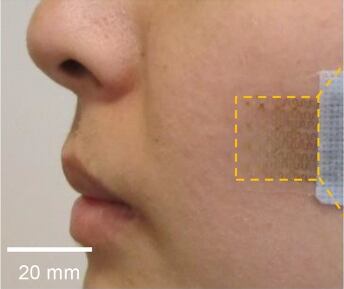The skin is, after all, our body’s largest organ and can actually communicate with us, says L’Oreal, to let us know about its thermal condition, thickness of its outermost layer, and heat transfer; which in turn can provide us with information and analysis of the effectiveness of active compounds.
By wearing a band aid-like device like the one pictured at the top of the page, it means that companies can find out the condition of the skin at certain points and develop products that specifically target certain issues.
“Developments in wireless technology will provide a path to continuous monitoring of skin properties and function using these concepts,” says the research team.
Study
The French cosmetics maker embarked on this study with the help of the University of Illinois at Urbana-Champaign and Tampere University of Technology, publishing the paper, ‘Thermal Transport Characteristics of Human Skin Measured in Vivo Using Ultrathin Conformal Arrays of Thermal Sensors and Actuators’ in PLOS ONE.
The study measured the relationships between skin hydration and in vivo thermal properties shown across six body locations (cheek, dorsal and volar forearm, wrist, palm and heel pad) on 25 subjects.
This was done using an ‘ultrathin’ device, or epidermal thermal sensing array, which is a silicon wafer coated in a transparent thermoplastic and containing miniature structures to make the various measurements.
A thin, flexible, conductive cable bonded with heat and pressure to contacting pads at the periphery serves as a connection to external electronics.

The paper notes that by using the ‘ultrathin’ measurement device on the skin instead of traditional approaches, such as infrared thermography or invasive probes; intrinsic thermal transport properties of the skin can be measured.
This includes relationships to vascularization, blood flow, stratum corneum thickness and hydration level.
Non-invasive method
The data also reveals that the in vivo thermal transport properties of skin are not uniquely a function of hydration, but are also influenced by the structural makeup of the skin, as well as local blood flow characteristics.
“Obtaining similar data with alternative measurement techniques would require either expensive and complex optical thermography and laser heating systems, or bulky single-point probes that can have undesired effects on the skin properties of interest due the pressure that must be applied to skin when measured in vivo,” say the researchers.
“The device and data presented here provide a foundational step for a new approach to the measurement of in vivo skin thermal properties, as well as new statistical data about the correlations between skin thermal transport properties, and skin hydration and structural makeup.”
L’Oréal notes that immediate future studies will focus on dermatological diseases, such as melanoma, rosacea and hyperpigmentation and their progression over time.
